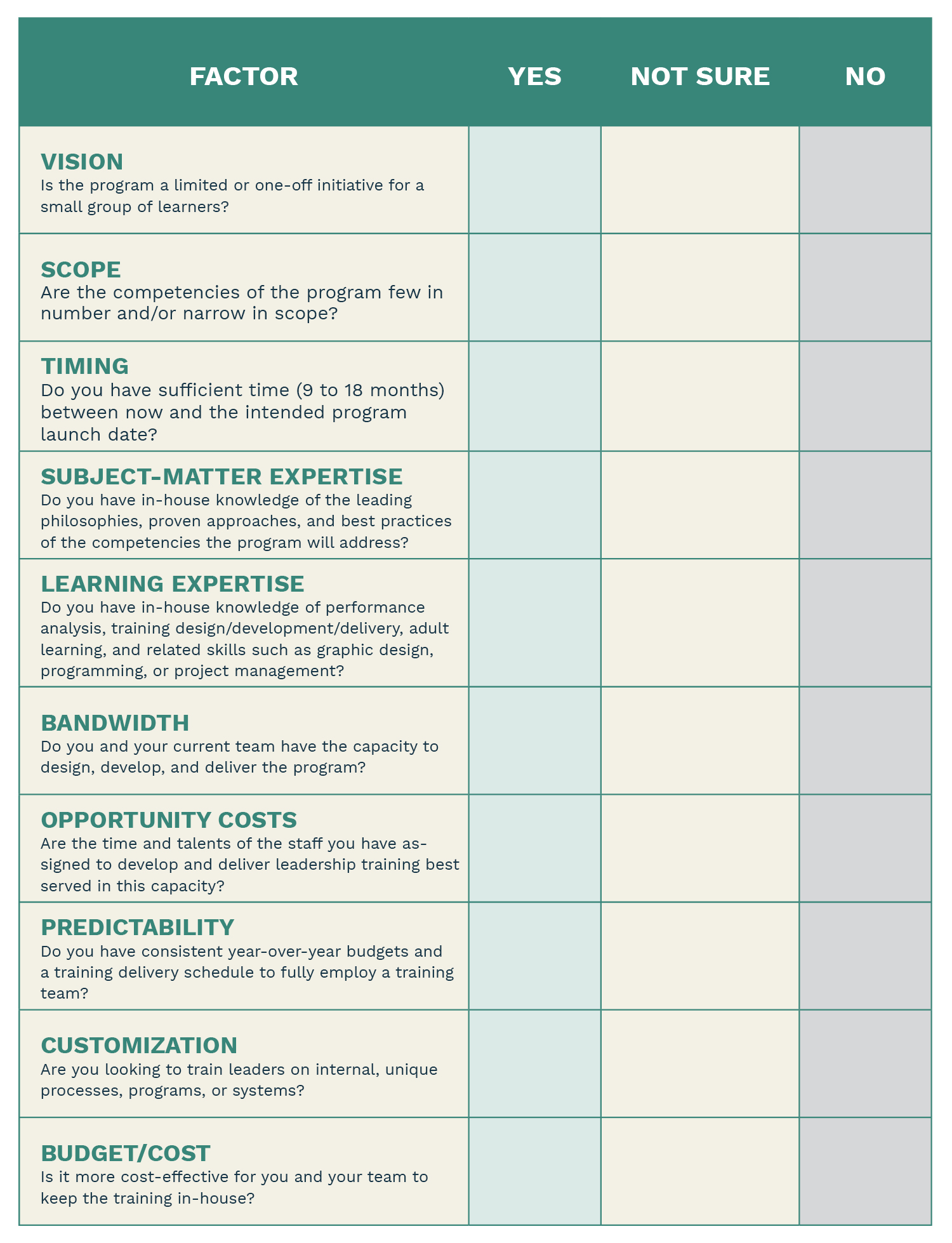According to legendary football coach Vince Lombardi, “Leaders aren’t born, they are made.” But how do you “make” a leader? At organizations big and small across a range of missions and industries, talent professionals know the value of offering targeted leadership development programs to “make” their leaders—specifically, make them stronger, more skilled, more effective, and better in ways that move both them and the company forward. When organizations invest in “making” their leaders all these things and more, they can expect to reap improvements in engagement, retention, performance, and bottom-line results, among other benefits.
But leadership development programs themselves are not born, either—they are made. What is the best way to “make” (and sustain) a leadership development program? Should you make it yourself or buy it ready-made from a consulting firm or training company, also known as outsourcing? The process for deciding starts with reviewing competencies, identifying performance gaps, determining learning goals, and making the business case that gives a program its structure and direction. Then, when it comes to creating the substance of a program, talent professionals have two choices: develop, deliver, and manage it themselves, or select a partner who offers ready-made or custom content and other solutions to lead the way.
The decision to make or buy (outsource) your leadership development program depends on many factors. Below is a comprehensive list of make-or-buy factors to consider when deciding on the best approach for your company:
Vision
Leadership development programs can range from simple, straightforward, short-term experiences for a small number of learners to comprehensive, long-term, enterprise-wide operations that incorporate multiple modalities and interventions, including individual coaching, group development, assessment tools, and certifications. Is your program a one-off initiative or part of a formal career-path system? Establishing the overall vision of your program is an important first step.
Scope
Performance outcomes that are specific, meaningful, and measurable are at the foundation of any learning program for leaders. Do you need a program that achieves a host of expected outcomes that cover a range of leadership competencies? Or are your outcomes more narrowly focused on one or two critical skills? Perhaps you don’t yet know the scope and require support to determine what your program’s learning priorities should be. A training consultant can provide that support.
Timing
Developing good content takes time. Depending on who is doing the estimating, it can take anywhere from 10 to 40 hours to develop one hour of training. Are you looking to launch a program as quickly as possible to address urgent needs or other expectations, or is your timetable more generous? Practically speaking, if you’re starting from scratch, the time it takes to hire, onboard, gain strategic commitment, design a program, gain access to materials, and finally schedule and facilitate the program is likely 9 to 18 months. If you are hemorrhaging talent or if performance deficits abound, you might not be able to wait that long to bring results to the organization.
SUBJECT MATTER EXPERTISE
Expertise counts. It’s wise to take stock of your internal expertise in the leadership competencies and behaviors the program is intended to address when determining whether to keep your learning program internal or to enlist an outside partner for help. Are you and your team up to the task? Solid programs are based on the work of thought leaders and researchers who have developed evidence-based models, philosophies, and best practices that have been shown to be consequential and sound; ready-made content sourced from consulting firms and training companies is likely to reflect this. Even basic competencies are rooted in proven methods. Conversely, your organization may want to promote approaches or ideas about a topic that is unique to your culture and can’t be found anywhere else (see Customization below).
LEARNING AND INSTRUCTIONAL DESIGN EXPERTISE
It’s also smart to consider your level of knowledge about adult learning, performance analysis, and training design and development. Again, are you and your team up to the task? Adult learners have unique needs and styles that training must address to effect the behavior changes your vision and desired outcomes require. And are you certain that training is even the right solution? Your intended performance outcomes may require interventions other than training to achieve—for example, shifts in corporate culture, better performance management support, improved processes and tools, revised pay and benefits structures, or other factors that have nothing to do with training. It’s important to sort that out so that you’re sure to pick the right solution. Furthermore, depending on vision and scope, your program may require the input of professionals skilled in graphic design, programming, project management, assessment, and evaluation. You may or may not have such expertise and resources at your disposal.
BANDWIDTH
Leadership development programs fail to get launched when the responsibility for the project falls on the plate of someone with an already-full slate of work. Well-meaning but uninformed leaders may think that a few hours of focus can produce a top-notch leadership development program. Someone inside your organization needs to determine the strategic talent management needs, allocate internal or external resources to meeting those needs, and oversee the results. Leadership development professions know that managing all the moving parts of a leadership development program can be a full-time job—and that is before considering content development and facilitation. For example, if training is not your full-time role, you may need a full day to review facilitation materials and practice before leading a class. Is this baked into your schedule, or will you be doing it at 10 o’clock the night before? Take time to map out all of the work, assign hours to each part, and then decide if you have the bandwidth to run the program internally or if you need to engage external leadership development services.
OPPORTUNITY COST
Even if you have someone dedicated to this work, ask yourself, is this the best use of their time? Allocating internal resources to develop and deliver training creates a trade-off for those people to not do something else. If it is a trainer, for example, would their time be better served developing technical training over leadership training? Or if it is a plant HR manager, would you rather have them spend time on recruiting or employee relations matters? The answer may be yes or no. But it is important to consider what else someone could be doing before you assign them the job to develop and deliver leadership training.
PREDICTABILITY
Consider the state of your business and staffing. Do you have a stable business providing you with a consistent budget to staff a leadership development department? And will those staff members be able to consistently fill their schedule with value-added training design and delivery activities? During past economic downturns, training departments were among the first casualties of dips in revenue. Does your organization’s CFO value more flexible spending levels to align with changing business profits? If so, retaining fixed staff may not be the best option for you.
CUSTOMIZATION
Are your business, culture, and leadership competencies so particularly unique that you require a customized set of tools, resources, models, and facilitation? Typically, work process training, including use of custom internal systems like performance management and application tracking, is designed from the ground up. Management, interpersonal, and leadership competency development is typically universal. People are people, and there are libraries of already established courses based on solid research to draw from, regardless of your culture and your brand identity. Don’t confuse the desire to have branded training materials with the requirement to build a training class from a blank page. With a small investment, you can customize exercises from off-shelf content. And you can hire a leadership development consultant who can understand and represent your brand and culture well.
BUDGET/COST
Cost can be measured in many ways. Time, resources, energy, capacity, and expertise all have a value that must be calculated and compared to what you would pay to partner with a leadership development firm. While it is relatively easy to calculate a cost per learner when buying your program from a leadership development partner, it is not as easy to arrive at the true cost of an internally lead program. Beyond the cost of salary and benefits of the trainer, make sure you add in less-obvious costs for that person’s computer equipment, office space, management time, and other hidden factors. And don’t forget the costs to provide them with professional development, certify them in training content, license software, and supply participant materials.
The checklist below can give you a quick yet complete analysis to help you make an informed decision.

If you find yourself checking more “Yes” boxes than “No” boxes, keeping your program in-house may be the most viable option for you. If you check more “No” boxes, working with a partner may be the way to go. If the number of “Not Sure” checks is significant, more thought and analysis is likely in order, or you may want to hire a professional firm to help you with the analysis. You may also prioritize one item in this checklist over another as strategically more important to your business. Indeed, there are many ways a leader can be made. Working through these ten make-or-buy factors can help you decide which way is best for your organization. If you’d like any help working through your decision, please don’t hesitate to schedule some time with me.
Read Next
Managers Are Cracking
We broke all previous attendance records at Dion Leadership’s March webinar—Managers Are...
Expanding Your Coaching Program to Create Leaders at All Levels
As a part of my work with Dion Leadership, I’m fortunate to hear updates and progress...




